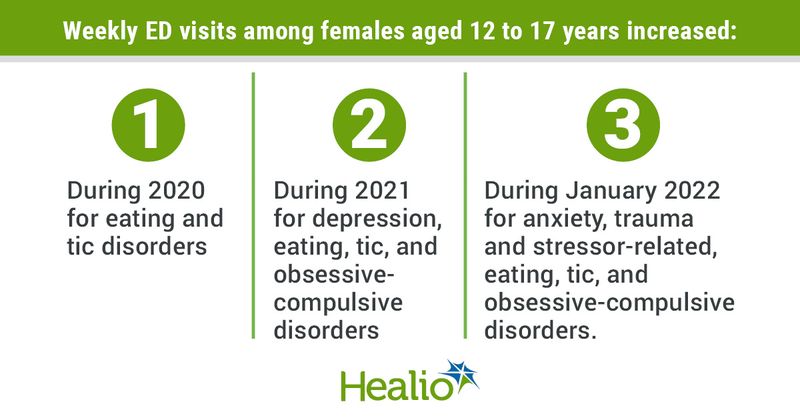ED visits for mental health surge among teen girls during pandemic
Weekly pediatric ED visits for eating and tic disorders have increased among females — especially adolescents aged 12 to 17 years — during the COVID-19 pandemic, according to a study published in MMWR.
It was one of two studies in which researchers assessed data from the National Syndromic Surveillance Program to compare pediatric ED visits from three pandemic surveillance periods with corresponding weeks in 2019.

Among adolescent females aged 12 to 17, weekly ED visits increased for eating disorders and tic disorders in 2020; for depression, eating disorders, tic disorders and obsessive-compulsive disorder (OCD) in 2021; and for anxiety, trauma and stressor-related disorders, eating disorders, tic disorders, and OCD during January 2022 — all when compared with 2019.
The researchers noted that although eating disorders could be triggered by “pandemic-related risk factors, (eg, lack of structure in daily routine, emotional distress and changes in food availability),” the increase in visits for tic disorders specifically is “atypical.”
“Tic disorders usually begin earlier in childhood and are more prevalent among males,” they wrote. “Stress of the pandemic or exposure to severe tics, highlighted on social media platforms, might be associated with increases in visits with tics and ticlike behavior among adolescent females.”
The authors suggested that pediatricians promote policies to “improve access to mental
health services, including telemental health, and community-based primary prevention strategies, to reduce exposure to adverse childhood experiences can help mitigate risk for MHCs before they begin.”
“Early identification and expanded evidence-based prevention and intervention strategies are critical to improving children’s and adolescents’ mental health, especially among adolescent females, who might have increased need,” they continued.
The other study found that, although pediatric ED visits declined by 51% in 2020, 22% in 2022 and 23% in January of 2022 — with most visits accounting for COVID-19 respiratory illnesses — numbers and proportions of visits did increase for certain injuries in the year 2021 compared with 2019, including firearm injuries, which increased by two visits per week; self-harm, which increased by six visits per week; and drug poisonings, which increased by seven visits a week.
“Health care providers and families should remain vigilant for potential indirect impacts of the COVID-19 pandemic, including health conditions resulting from delayed care, and increasing emotional distress and behavioral health concerns among children and adolescents,” the authors wrote.
The AAP and other pediatric groups in October claimed that a “worsening crisis in child and adolescent mental health” brought on by COVID-19 “and the ongoing struggle for racial justice” constituted a national emergency, citing findings that claimed approximately one in four youth globally are experiencing clinically elevated depression symptoms, and around one in five are experiencing anxiety — both double their prepandemic estimates.
References:
CDC. New reports on health and well-being of children during COVID-19 pandemic. https://www.cdc.gov/media/releases/2022/s0218-children-wellbeing-covid-19.html. Published Feb. 18, 2022. Accessed Feb. 21, 2022.
Radhakrishnan L, et al. MMWR Morb Mortal Wkly Rep. 2022;doi:10.15585/mmwr.mm7108e1.
Radhakrishnan L, et al. MMWR Morb Mortal Wkly Rep. 2022;doi:10.15585/mmwr.mm7108e2.

